Emily Lakdawalla • Jul 15, 2015
First look at New Horizons' Pluto and Charon images: "baffling in a very interesting and wonderful way"
The New Horizons spacecraft has only had time to downlink seven LORRI images since its flyby of Pluto yesterday. Today's press briefing at the Applied Physics Laboratory in Maryland was preceded by hours of New Horizons team members cryptically dropping hints on Twitter at astonishing details in those few images. And the images are astonishing, as well as beautiful, surprising, and puzzling. Team member John Spencer aptly summed them up when he described them as "baffling in a very interesting and wonderful way."
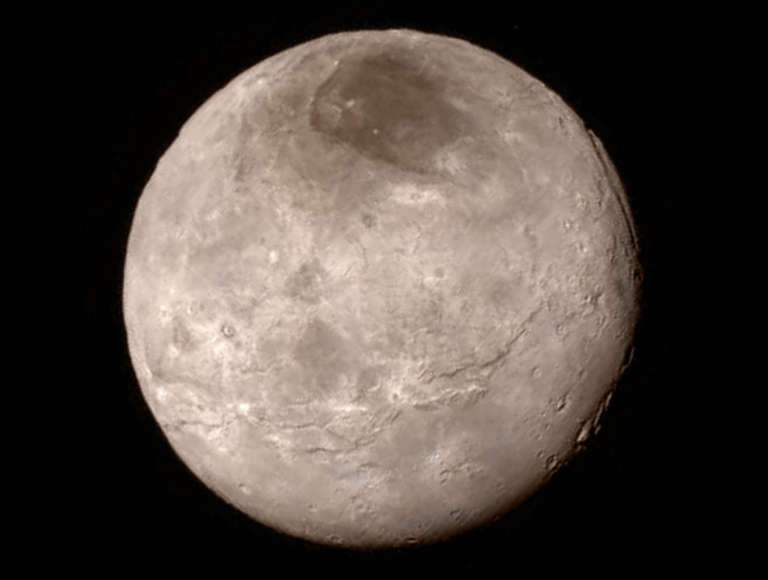
Here's how Cathy Olkin described it (I did my best to transcribe as she talked, but did so imperfectly, so consider this a paraphrase, and I also convert Imperial units to metric):
Look at the north pole (informally referred to as Mordor). The red coloring extends beyond just the deepest darkest part of that polar region. Dark coloring could perhaps be a thin veneer, because you can see craters poking through. The darker area is polygon-shaped, while wider red area is more diffuse. Farther down on the disk, from northeast to southwest, is a series of troughs and cliffs. Striking, amazing. That could be due to internal processing. Just below that is a region where it's relatively smooth; there's less craters. Perhaps there's recent resurfacing in that area, so that's very exciting to see as well.
Near the top, at about 2:00, you can see a long, linear feature, and a notch where you're looking through to space on the other side. That canyon is really quite deep, like [6 to 10 kilometers] deep. I find that fascinating. It's a small world with deep canyons, troughs, cliffs, and dark regions that are still mysterious to us. Another canyon at about 10 or 11:00 is [5 kilometers] deep. So much science in this one image alone. Soon we'll get a higher resolution image that won't get all of Charon that will have a factor of 5 better resolution. Pluto did not disappoint; I can add that Charon did not disappoint, either.
Why are these features so surprising? Look at the worlds that are similar in size to Charon, such as Dione and Tethys. Charon has way too few craters for a body of its size. That implies a very youthful surface. That broad, smooth area near the bottom, in particular, is geologically quite young. And there is a diverse array of terrains visible in this image. I never expected Charon's story to be so complicated. I can't wait for higher-resolution images.
There are other bodies in the solar system similar in size to Charon: Ariel, Umbriel, and Oberon. They, too, have some craters, as well as chasms. Yesterday, people were saying Charon looked more heavily cratered, hence, older. Seen at higher resolution, Charon is looking younger than we thought. Now I really, really wonder, if we could look more closely at Uranus' moons, would we see more youthful surfaces than we thought?
The other most amazing image of the press briefing was Pluto, seen at high resolution. It is in the bright area that we have been informally calling the "heart" but which now has a still informal but slightly more official name: Tombaugh regio, named for the discoverer of Pluto. It is located near the southern end of Tombaugh Regio, near the terminator, where the Sun glances across the landscape at a low angle, highlighting topography. And oh my goodness, what topography.
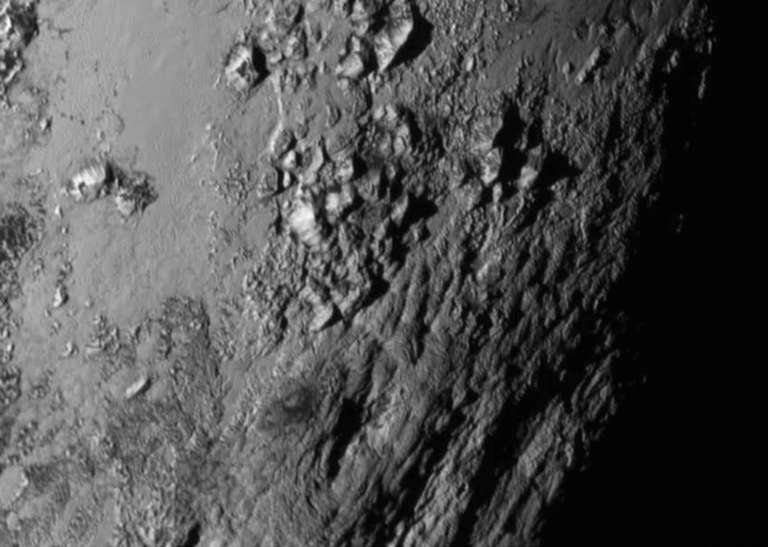
This close-up image of a region near Pluto’s equator reveals a giant surprise: a range of youthful mountains rising as high as 3,500 meters above the surface of the icy body. The mountains likely formed no more than 100 million years ago—mere youngsters relative to the 4.56-billion-year age of the solar system—and may still be in the process of building, says Jeff Moore of New Horizons’ Geology, Geophysics and Imaging Team (GGI). That suggests this region, which covers less than one percent of Pluto’s surface, may still be geologically active today. Moore and his colleagues base the youthful age estimate on the lack of craters in this scene.
The image was taken about 1.5 hours before New Horizons closest approach to Pluto, when the craft was 77,000 kilometers from the surface of the planet. The image easily resolves structures smaller than a mile across.
Image: NASA / JHUAPL / SwRII see a minimum of four distinct terrain types in this image, and not one of those four is an impact crater. Plus really interesting albedo variations (though those could be textural effects rather than albedo, given the low angle of the sunlight). Here's what John Spencer had to say about the image (again, paraphrased, combining in some responses to later questions from media, and also metric-converted):
We haven't found a single impact crater on this image. Pluto is being bombarded by other objects in the Kuiper belt; craters happen. Eyeballing it, we think it has to be under 100 million years old; it might even be active right now. Mountains are up to [3500 meters] high. We know the surface of Pluto is covered with nitrogen and methane and other volatile ices; you can't make mountains out of that stuff. We are seeing the bed-ice of Pluto. Water ice is strong enough to hold up big mountains, and that's what we think we are seeing here.
What's particularly exciting to me about this is that this is the first time we've seen an icy moon that isn't orbiting a giant planet. We usually attribute strange features on icy worlds to tidal heating. That can't happen on Pluto. There is no giant body that can be deforming Pluto on a regular basis; Charon is too small to do that. This is telling me that you do not need ongoing deformation from a giant planet to power deformation on an icy body. That's a really important discovery that we just made this morning.
We will have more of this mosaic to show you on Friday.
We have no idea at this point how mountains formed. Triton doesn't have this kind of rugged terrain. It has a lot of strange materials, but it doesn't look at all like this.
The terrain to the lower right looks really strange. It's like piles of stuff with grooves on it. It's baffling in a very interesting and wonderful way. I don't think it looks like the surface of a lava flow, but perhaps a similar process happening on a much larger scale.
[In response to a question about how Pluto and Charon could retain heat for so long]: We have a couple of options. We know there's radioactive material inside Pluto and Charon; radioactive heat is powering geology inside the Earth. It may be telling us that even small bodies, if they're icy, can store heat. Maybe they can store heat for a long period of time.
Those mountains are something else. They don't line up like impact crater rims. There are kind of similar mountains on Io, but this weird dense patch isn't a perfect match to that. Earth has pointy mountains, but Earth also has water erosion. So how's this for a going-out-on-a-limb, crazy idea: Are Pluto's mountains like Earth's or Titan's? Have they been eroded into their present shapes by fluid flow: water on Earth, methane on Titan, and, I don't know, nitrogen or neon on Pluto?
With both Charon and Pluto appearing so youthful, my first question about this was: is it time to consider the idea that the Charon-forming impact happened a lot more recently than we thought? I asked the question at the press briefing, but as it was my second question they didn't answer it. I've been polling scientists since, and while geologists like the idea, dynamicists say that the odds of such an impact happening late are "infinitesimal" (that's a quote from Bill McKinnon). I asked him whether a late impact is less likely than retaining primordial heat to the present day, and he -- a geophysicist -- seems to prefer rethinking his geophysics work to considering a late impact.
One really important point about this image, to me, is that it does not look anything like Triton seen up close. As a reminder, this is Voyager 2's highest-resolution observation of Triton:
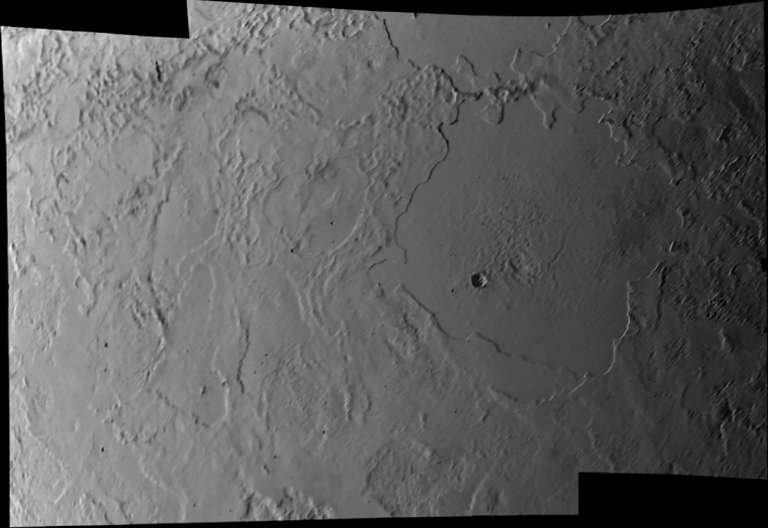
From a distance, Pluto and Triton have many similarities, but seen up close, it's clear that the two have very different geologic histories. I think this demonstrates how important the kind of resolution you can only get from spacecraft encounters is to understanding the history of a world. We can't write the story of Pluto's history yet -- it'll take years of work on New Horizons' data to do that -- but it's safe to say that its geologic history is quite different from Triton's.
A very recently-published open-access paper by Amy Barr and Geoff Collins, "Tectonic activity on Pluto after the Charon-forming impact," hints at what might have driven tectonic activity on these bodies. I asked Amy to say a few words about this work that would be relevant to the just-released images:
The pictures are showing a potentially younger and evidence of some surface activity. The question is what is driving the activity.
A paper by myself and Geoff Collins published earlier this year in Icarus suggests that activity may be kick-started by the Pluto/Charon impact if Pluto is warm (ice layer warmer than, say 200 K) before the impact.
If that is the case, we would expect that the bodies could have significant tidal dissipation in them, perhaps enough to drive a brief bloom of geological activity on both bodies.
The basic physical principle is that a body that is hot before the impact will be mushy enough to experience tidal heating in the subsequent orbital evolution to get hotter. (The hot get hotter and the cold stay cold, if that makes sense.)
Every time we have looked at a body that has experienced tidal heating, such as Io, Europa, Enceladus, we find that the body has been more active, or is putting out 10 to 100 times the amount of heat predicted by models.
Enceladus taught us that our models of tidal heating for icy bodies were not right, and I think the Pluto/Charon system could be telling us something similar.
Food for thought. Thanks, Amy, for responding to my call so fast.
They released two other images at the briefing. Here is the first well-resolved image of Hydra, which settles the question of its size and shape. The best previous estimate, based on Hubble data, was 58 x 34 kilometers, quite elongated. This image shows it's even smaller than that -- 42 by 33 -- but one reason for the smaller big dimension is that the moon appears to be bent!
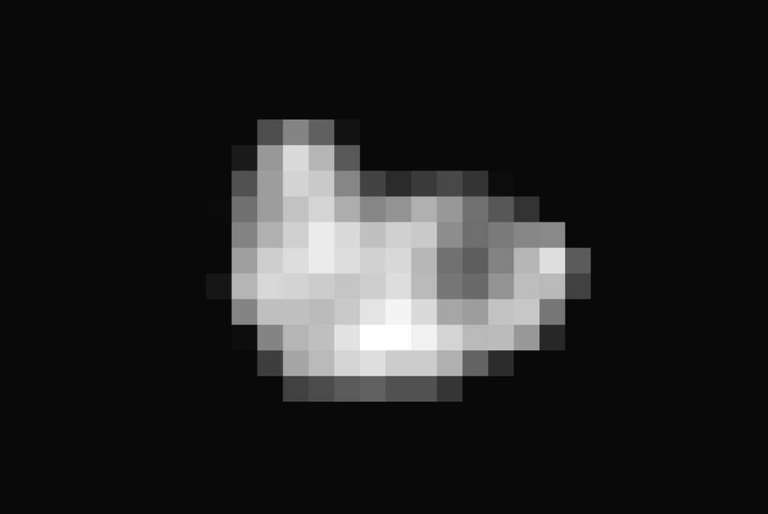
Since its discovery in 2005, Pluto's moon Hydra has been known only as a fuzzy dot of uncertain shape, size, and reflectivity. Imaging during New Horizons' historic transit of the Pluto-Charon system definitively resolved these fundamental properties of Pluto's outermost moon. Long Range Reconnaissance Imager (LORRI) observations from a distance of approximately 640,000 kilometers revealed an irregularly shaped body characterized by significant brightness variations over the surface. With a resolution of 3 kilometers per pixel, the LORRI image shows the tiny potato-shaped moon measures 43 kilometers by 33 kilometers.
Like that of Pluto's largest moon Charon, Hydra's surface is probably covered with water ice. Observed within Hydra's bright regions is a darker circular structure approximately 10 kilometers in diameter. Hydra's reflectivity is intermediate between that of Pluto and Charon.
Image: NASA / JHUAPL / SwRIThis is a tantalizing image -- it tells us the size and shape of Hydra, but it contains variations in brightness that speak of either albedo variations across the surface or a double- or even multiple-lobed shape, or both albedo variations and lobe-y shape. The phase angle of this image is only 16 degrees -- very close to "full" -- so its crescent shape is not due to lighting; it's due to the actual shape of the moon. Is it like Churyumov-Gerasimenko? Hydra is a lot bigger than Rosetta's comet. Remember, the eventual extended-mission target of New Horizons will be a body of comparable size to Hydra.
The other image released today included spectra of the surface from the Ralph LEISA instrument. They windowed the data, returning only a portion of the spectrum, including the portion where methane is strongly absorbing.
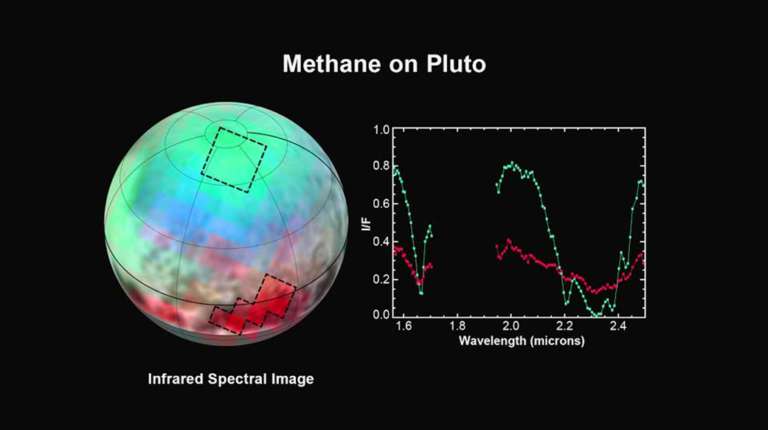
Pluto's polar cap shows a very deep methane absorption. There is also methane in the dark region, but the absorption is not as deep, suggesting that there is something in there that is scattering more light. (If you had a photo of Pluto in a methane absorption band, the polar cap would look nearly black, while the dark regions would be bright! This is just the bare minimum of information that can be wrung from this image; it serves as a hint of the science to come.
The next press briefing is scheduled for Friday afternoon at either 1:00 or 2:00 and will be held at NASA Headquarters; I will go down to Washington, D.C. to attend in person. The next briefing after that is a week from Friday. There are not currently any stated plans for image releases tomorrow but I am hopeful that they will throw us Pluto fans a bone with at least one image release, if not more; they should be able to show us Nix, at least. I've been updating my "what to expect" post as plans change, but here's the relevant stuff for the rest of this week, fodder for the Friday briefing:
Thursday, July 16 at 04:23 UT / 00:23 ET / Wednesday, July 15 at 21:23 PT: 1.9hr downlink: First Look C
- PEPSSI data (no LORRI or MVIC images)
Thursday, July 16 at 07:23 UT / 03:23 ET / 00:23 PT: 1.9hr downlink: First Look D
- 3 frames on Charon from high-resolution LORRI mosaic at 0.38 km/pix (Charon will fill frame, each frame ~390 km wide). Taken 2015-07-14 10:23:47. Range 79,000 km. - The highest-resolution images of Charon that will be available during encounter period
- PEPSSI and SWAP data
Thursday, July 16 at 13:22 UT / 09:22 ET / 06:22 PT: 4.3hr downlink: First Look E
- MVIC Pluto and Charon color at 5.0 km/pix (~480 and ~240 pixels across disks). Taken 2015-07-14 06:49:08. Range 254,000 and 269,000 km. - Color portrait of Pluto & Charon in same image
- SWAP data
Stay tuned! They are kicking us out of the media center shortly, so that's all I'll have time to post today.
The Time is Now.
As a Planetary Defender, you’re part of our mission to decrease the risk of Earth being hit by an asteroid or comet.
Donate Today

 Explore Worlds
Explore Worlds Find Life
Find Life Defend Earth
Defend Earth

